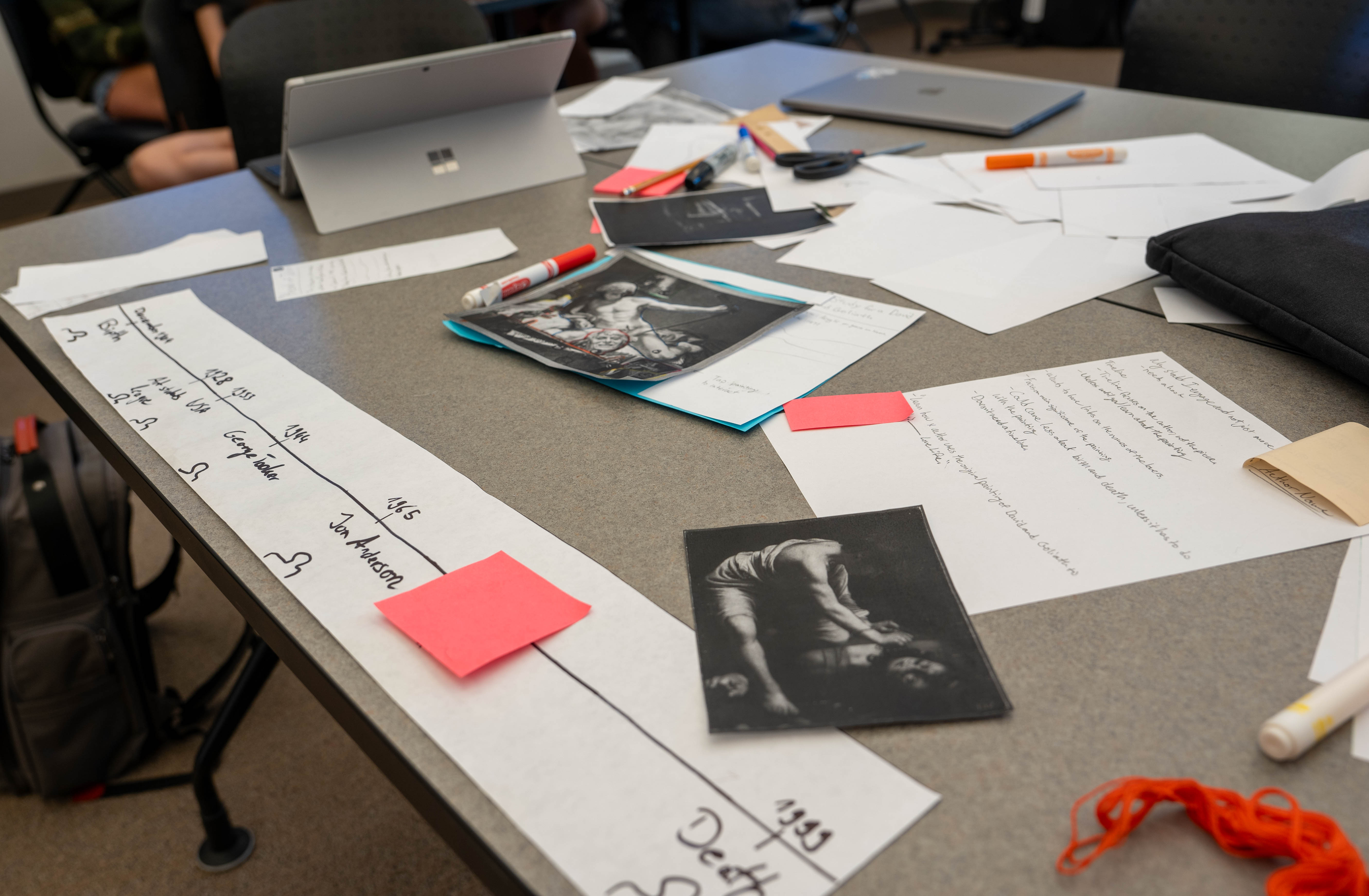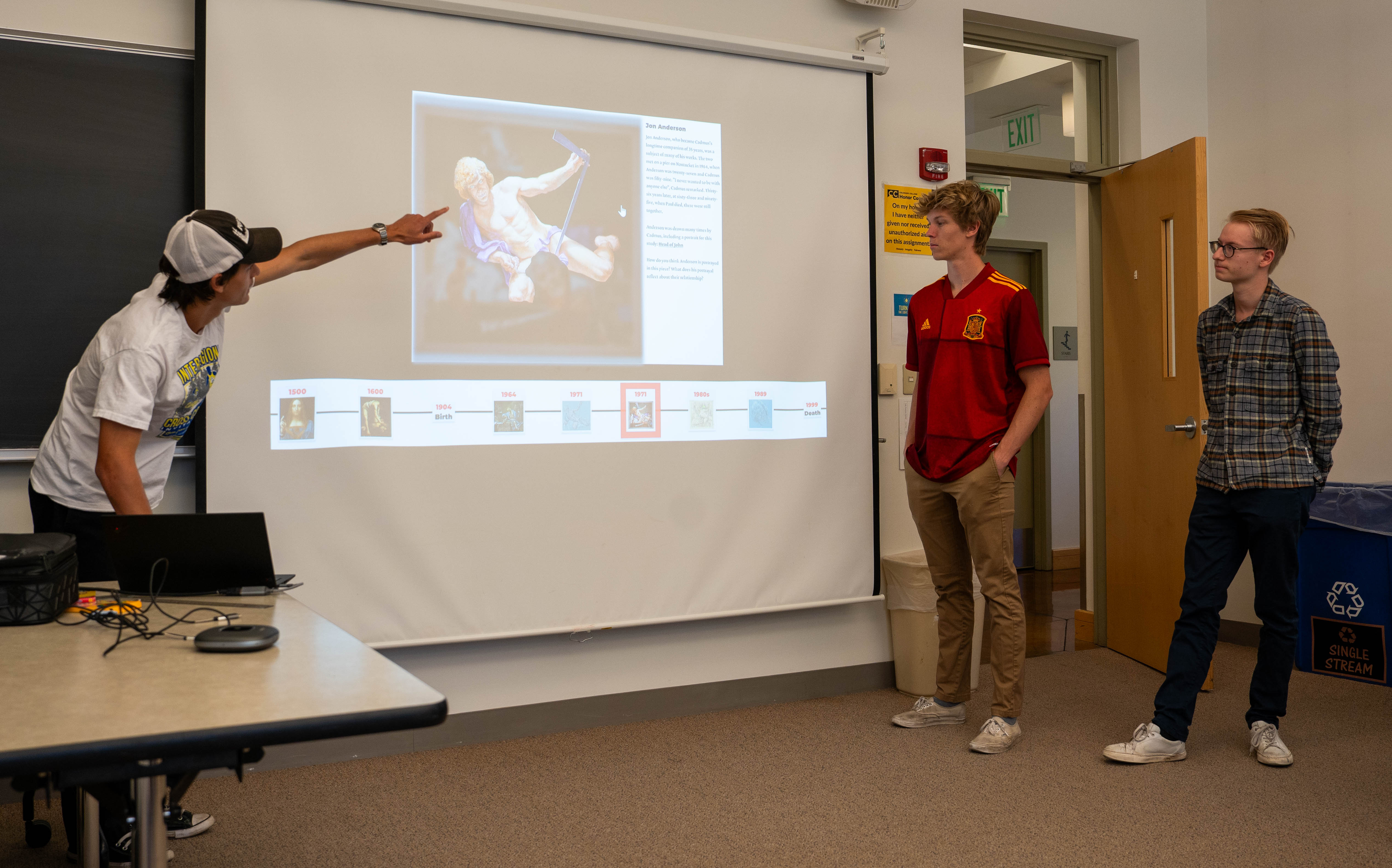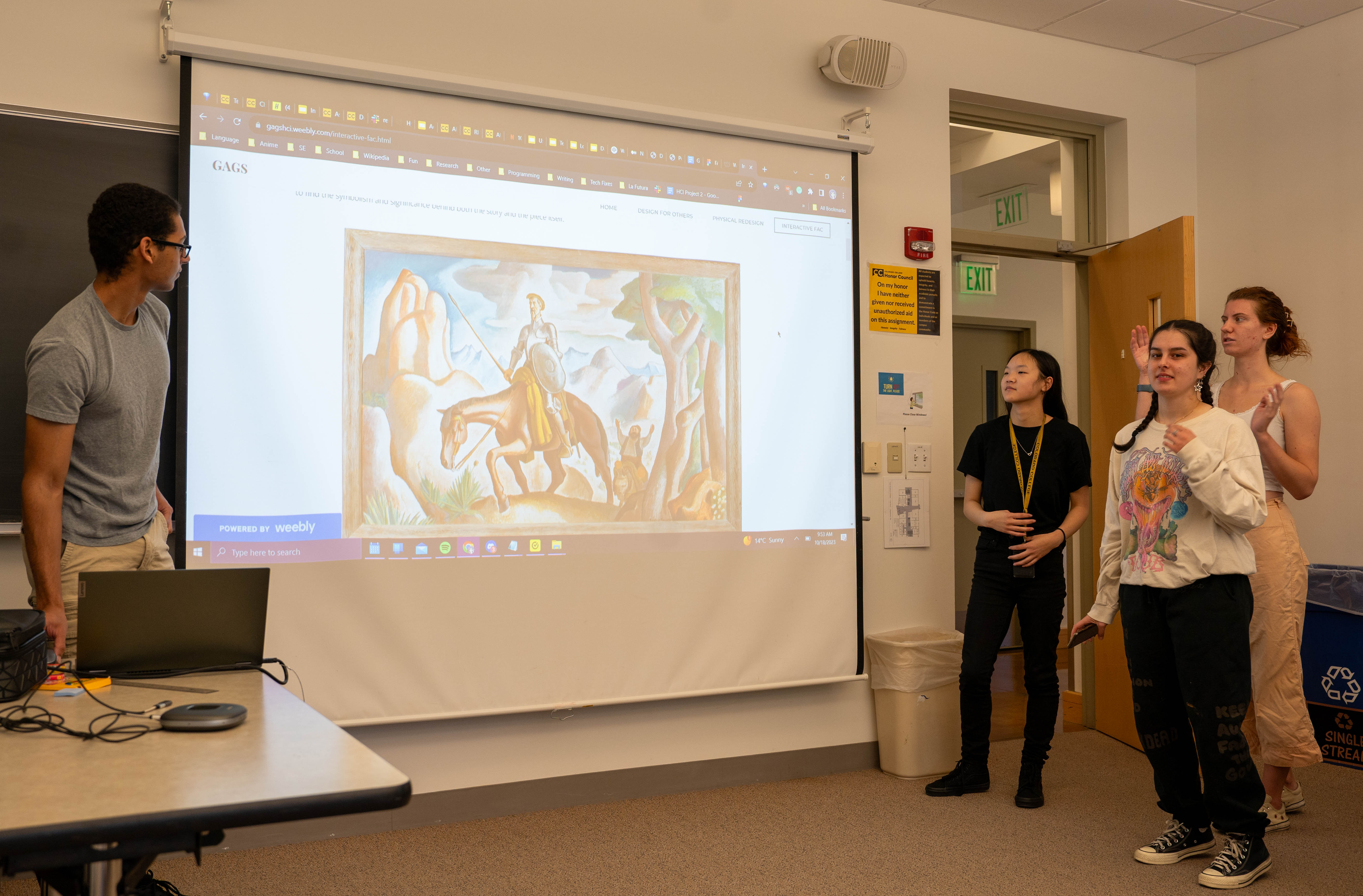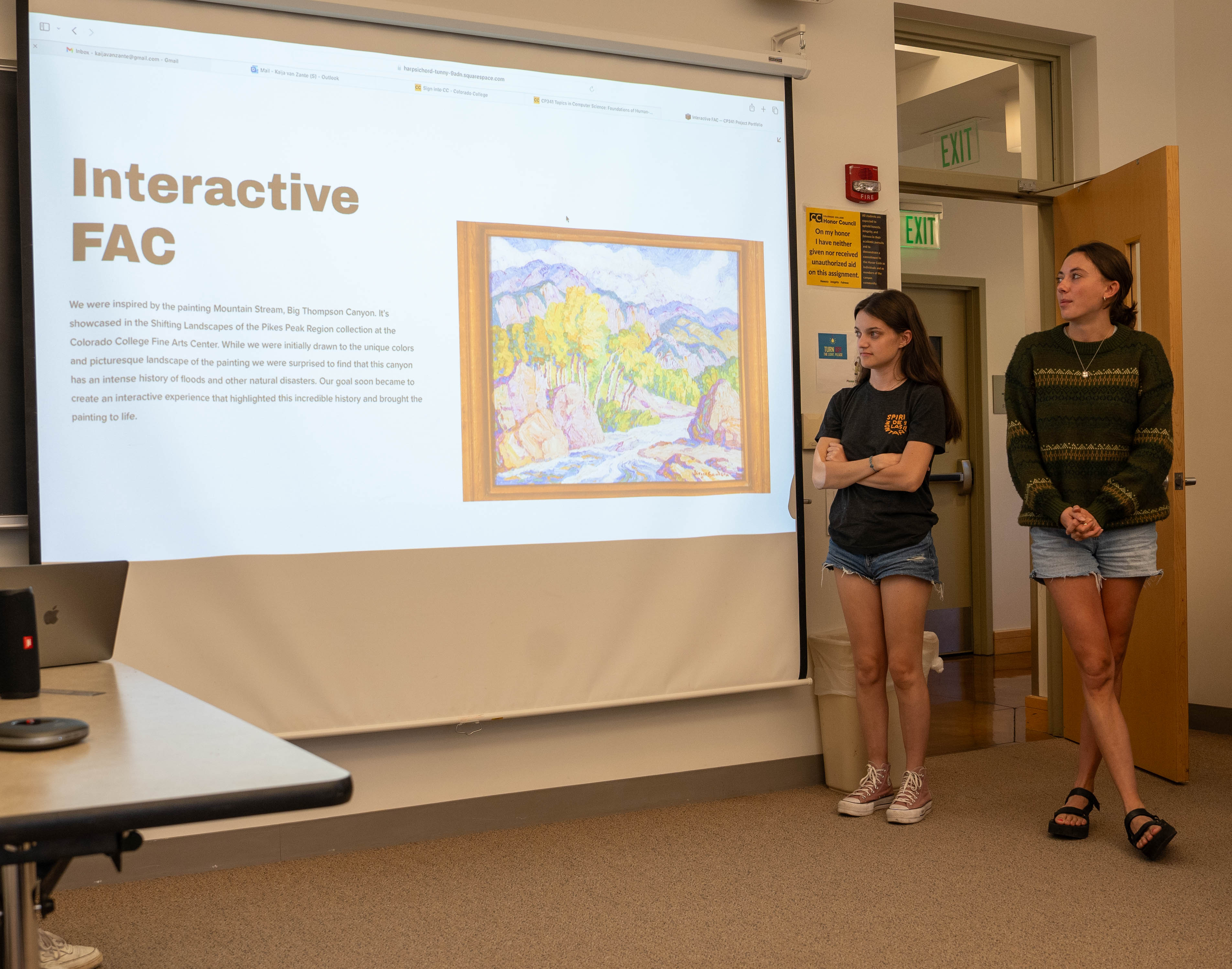There’s no doubt that in 2023, smart technology is becoming increasingly widespread. But what happens when computer scientists create applications without considering people in their design? Best-case scenario: the product is functional but goes unused. Worst-case scenario: possible discrimination, loss of access, and more. Assistant Professor of Mathematics and Computer Science Dr. Varsha Koushik spent three-and-a-half weeks teaching her students the importance of considering the potential impacts on people, cultures, and groups when designing interfaces. Luckily for her students, CC’s liberal arts education has prepared them to face these challenging questions and discussions while they work to create a more just future.
Students in Koushik’s Foundations of Human-Centered Computing learned about human-computer interaction research, which centers the study of computer science on the relationship between people and computing.
“The goal of the class was to introduce students to the user-centered design process and enable them to define problems and develop solutions through the lens,” says Koushik, whose research focuses on exploring accessible smart technologies as a way to empower people with disabilities. “Furthermore, the course teaches existing research practices in human-computer interaction and helps students critically think about emerging technologies and their impact on our society.”
To accomplish this goal, Koushik used a combination of readings, discussions, lectures, in-class activities, homework, and group design sprints. Koushik began each class with a warmup exercise called Good Design/Bad Design, where she would display a picture of a design and ask students to vote on how well the design would function. “The exercise was to help students get into the class first thing in the morning but also for them to see how their design thinking evolved from day one to day eighteen,” Koushik says.
Computer scientists often use the word “design” exclusively in the context of programming and architecture, which can result in complex products that are functional, but not really used. This is because some computer scientists neglect people in their design. In this class, Koushik taught students the importance of studying both people and technology in computer science. A design can be great, but still be completely unusable if the designer doesn’t consider humans in the code.
“Just because we use an application or are somewhat familiar with it doesn’t mean it’s good,” Koushik says. “For example, you might find plenty of websites that work well on the desktop or laptop but are terrible to navigate on your phone. It becomes extremely difficult for users to navigate the application. In this case, the developers did not work with users on how and when their users might use their application. Students learned to overcome unexpected consequences, or, I would rather phrase it as creating a human-centric design through iteration - a key user-centered design principle. You create a low-fidelity version of your prototype and test it with users. Then, iterate on your design. Again, test with users. Keep repeating this process until you find a version that works well with most users.”
August Knox ’24 says one of his favorite parts of the class was the design scavenger hunts throughout the block, which gave him the opportunity to view designs through the perspective of others.
“Most Wednesdays, we would be tasked with finding a few examples of both good and bad design around campus,” says Knox, a Computer Science major. “Throughout the week, we would then guess in class whether the example provided was good or bad. It did a great job of getting us thinking about design choices all around us that we don't even consider during everyday life, and how certain design choices may impact some people differently than others.”
While this was a Computer Science class, Koushik made sure to emphasize the human impact that design and coding can have, which is a lesson students appreciated.
“There was a lot of discussion of ethics, more so than any other computer science class that I had taken previously at CC,” Knox says. “As this class was all about designing products to be used by everyone, disabilities, societal conventions, and individual preferences were all things that we had to consider when working on each of our projects."
Koushik partnered with the Colorado Springs Fine Arts Center at Colorado College (FAC) for the course’s final project. Students picked a project from a list of different art pieces and had to make them holistically interactive, implementing a user-centered design process.
“This project is not as easy as it looks because your user can be anyone - from an art student to someone without knowledge about art,” Koushik says. “How do you design an experience that works for most people? Secondly, what does holistically interactive mean for a painting? Students were specifically told that just taking information about the painting and making it an audio application or just clicking on the painting to learn about it will not suffice. It has to go beyond gaining information that might be written about the painting next to it in the museum.”
The 11 students were divided into three groups for the final project. Each group created a website that outlined their process, personas, prototype, and testing.
Gwen Hardwick ’24, Alisha Bloom ’24, Grace Ivaska ’24, and Silas Blanchard ’24 chose “Don Quixote and Sancho” by Boardman Robinson. For the project, the students made an interactive display to help viewers understand the painting's context, story, and meaning. Based on interviews with possible users, the students created two user personas, an affinity diagram, and a “How We Might” statement to begin the process of developing their design.
The group’s “How We Might” statement is as followed:
Given the fact that viewers struggle to understand the significance and meaning of “Don Quixote and Sancho” by Boardman Robinson, how might we design an interactive display to support both those with prior knowledge and those who are new to the art style or story so that the piece is accessible and engaging to a variety of viewers.
The group used an interactive mood board for their information design, specifically using colors pulled from the painting. They then created a storyboard and low fidelity prototype. Following planning and creating the paper prototype, the students conducted user tests and then created a Figma prototype.
“I learned to much more effectively communicate with group members and different design philosophies that allow for maximizing the number of people who can use a product,” says Blanchard, a Computer Science major.
To view the final demo, please check out the group’s FAC Demo video and FAC Tactile Demo video. Please check out the group’s webpage for more information about the project.
Students in another group chose “A Study for a David and Goliath” by Paul Cadmus. For their redesign, students in the group followed a similar interview and “How We Might” process. After creating the story and mood board, the students in this group conducted user tests with their low fidelity prototype. Following the user tests, they changed several features based on the tests, and created a Figma prototype.
“This project was difficult for our group because we didn't want to overly direct our user's experience with the piece,” says James Settles ’24, a Computer Science major and member of the “A Study for a David and Goliath” group. “There is a fine line between helping someone feel empowered and confident in a museum space and telling them how they should feel or interact with a piece."
To see the final demo, please check out the group’s medium fidelity prototype video. For more information about the project, please visit the group’s webpage.
Collaborating with the FAC was a great experience for students, as it gave them an opportunity to participate in interdisciplinary learning. The FAC is a vital resource for the CC community, regardless of major or department affiliation. Last year, the FAC worked with over 70 different courses to organize 115 total class visits and collaborated with 52 different faculty members across 26 academic departments, demonstrating how the FAC is a tool for all majors.
Knox’s group used a painting of Big Thompson Canyon, located in northern Colorado, for their final project. “This was the site of a deadly natural disaster many years ago, so we used an interactive display with ambient sound and narration to tell the story of this event in an interactive way,” he says. “A class with no coding was something I hadn't taken yet for my major, and the focus on human-centered design seemed really useful no matter what field I choose after college.”
Students also learned need-finding practices for specific human-computer interaction tasks with another group project, where students interviewed and observed three users in their target group. Once the groups completed the need-finding process and developed a prototype, they conducted a user study with the target users to get feedback on their prototypes. One homework assignment was to create a prototype for the Computer Science website for a smart display. Some students created a joystick for a tabletop smart display; others created a vending machine.
“The most interesting part was accessibility, something I greatly benefit from but rarely think about,” Blanchard says. “I never learned its history or how useful it was until this class.”
While the group projects were a highlight for many of the students, the class also wrote design manifestos, where students illustrated their design philosophy with themes.
“It was interesting to try to articulate our design philosophy through our manifesto,” says Knox. “We chose five different points to base our manifesto around, based on our experiences through the block. It was a good way to look back on some of the topics we had covered throughout the last month, while allowing us to choose a few topics that really resonated with us.”
“This manifesto demonstrated their learnings from this class because they used their classwork as evidence to describe their design philosophies,” Koushik says. “This is a unique outcome of the class and one you will rarely find in other classes.”






